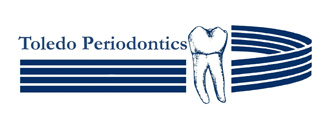Implant Treatment Options
When teeth are lost due to injury, tooth decay (cavities) or periodontal disease (infection of the gums and bone), a dental implant may be a treatment option for replacement of missing teeth. The surgical portion of placing an implant usually involves two surgical appointments. A dental implant is an artificial tooth root made out of titanium that is placed into the jaw bone at the first surgical appointment. You will be numbed with a local anesthetic (“novocaine”) and completely comfortable for this procedure. If you have any concerns about dental anesthesia, please read about options available to you under our “Anesthesia” tab. A healing abutment (or healing cuff) is placed on top of the implant, and the gum tissue is sutured (stitched) over the implant and you are sent home to heal for 4 to 6 weeks. Once the jawbone fuses or “integrates” with the implant, a short, second surgery is performed to remove the healing abutment and place the final abutment, which will serve as a connecting piece to join the implant to the final artificial tooth that will be placed by your general dentist. Once your gums have healed around the final abutment, an artificial tooth is custom-made by your general dentist and then placed on the implant. Dental implants are a comfortable, affordable and long-lasting option for replacing one missing tooth or several missing teeth.
A dental implant is an artificial tooth root that a periodontist places into your jaw to hold a replacement tooth or bridge. Dental implants are an ideal option for people in good general oral health who have lost a tooth or teeth due to periodontal disease, an injury, or some other reason. Dental implants are so natural-looking and feeling, you may forget you ever lost a tooth.
Under proper conditions, such as placement by a periodontist and diligent patient maintenance, implants can last a lifetime. Dental implants are intimately connected with the gum tissues and underlying bone in the mouth. Since periodontists are the dental experts who specialize in precisely these areas, they are ideal members of your dental implant team. Not only do periodontists have experience working with other dental professionals, they also have the special knowledge, training and facilities that you need to have teeth that look and feel just like your own.
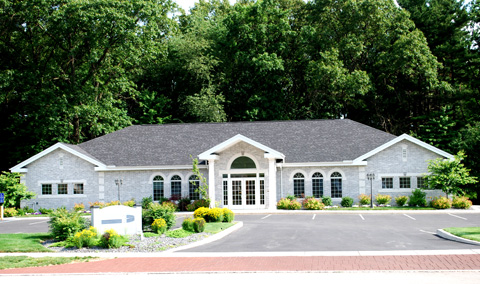
Dr. Tohme and dentist will consult with you to determine where and how your implant should be placed. Depending on your specific condition and the type of implant chosen, your periodontist will create a treatment plan tailored to meet your needs.
Implants have many benefits. An implant looks and feels much like a natural tooth. Because the implant mimics the root of a natural tooth, the jawbone is stimulated with chewing. This helps keep the jawbone strong and healthy, and this keeps the implant secure within the jawbone. An implant can be used to replace a single missing tooth, many teeth or a fixed bridge. Implants are often used to support full dentures, preserving precious jawbone and keeping dentures comfortable, secure and stable.
You, your general dentist and Dr. Tohme will work closely together as a team throughout the implant process. Dr. Tohme will prepare your jaw and surgically place the implant and final abutment, while your general dentist will make the prosthesis (artificial tooth to be place on the implant) by taking an impression of your jaws, teeth and abutment(s). From these impressions, a custom-made artificial tooth, teeth or denture will be made and placed in your mouth.
Implants are easy to maintain with good oral hygiene. They simply require thorough daily brushing and flossing and regular checkups with the dental team.
Please feel free to contact the Toledo Periodontics office so that we may arrange a consultation appointment to see if dental implants are an option for you.
LOSS OF NATURAL TEETH:
Your own healthy, natural teeth are always the best dental option you can possibly have. There is nothing else which compares with them. Therefore, it is in the best interest of your good health and well-being to do anything you can to keep your teeth in the best condition for the longest possible period of time. When this is not possible and a single tooth or many teeth are lost due to an injury, cavities, or gum disease, several options exist to replace missing teeth.
SUPPLEMENTING NATURAL TEETH WITH A FIXED BRIDGE:
If teeth are lost, it is best to replace them as soon as possible. A fixed bridge is often recommended to replace a single missing tooth or multiple missing teeth. Making a fixed bridge involves removal of the enamel from at least one tooth on either side of the missing tooth or teeth. These supporting teeth that are ground down will anchor the bridge. A potential concern is that the bridge does not possess the same degree of root support as all of the teeth that it will replace. This may not be a significant problem when dealing with replacement of a single tooth. However, loss of two, three or more teeth in a row, or losing several teeth spread out intermittently throughout the entire arch, quickly becomes a concern as a considerable amount of root support has been lost. The load on the remaining teeth has been significantly increased, because there are fewer of them. This can be compared with losing fence posts in a long fence. The fence is not any shorter, but there are fewer posts supporting the fence. As a result, the fence is not as strong as it was earlier.

PARTIAL DENTURES:
A removable partial denture is another option that is sometimes recommended for replacement of a single missing tooth or several missing teeth. These can be removed from the mouth at will. Most consist of a stable metal framework made of chrome cobalt, which clasps around remaining supporting teeth in the arch. Sometimes a plastic acrylic resin partial, often referred to as a “flipper” is constructed to temporarily replace one or two missing teeth on the upper arch. The missing teeth are attached to the metal or plastic framework and are made of porcelain, plastic resin or metal. All partial dentures are constructed differently. Some receive support entirely from the remaining teeth, some are supported entirely by your oral tissues as they rest only on the palate. Others are supported by both the teeth and the oral tissues. If the partial is tooth supported in any way, the load on the remaining teeth has once again been increased. Additionally, in areas where the missing teeth are tissue supported, the forces of chewing may result in gradual shrinking of the gum and bone tissues in these areas.
Partial dentures may periodically need to be relined as teeth shift and gum and bone shrinkage occurs. Teeth supporting the partial denture often slowly lose bone support as they bear the load for the missing tooth or teeth. Partial dentures are also subject to movement with eating or speaking, and are usually removed at night to allow the underlying tissues to rest. Some patients experience difficulty with eating and speaking when wearing partial dentures. While this generally improves with time and use, some patients find that wearing the partial denture is never a natural feeling or comfortable solution for replacement of missing teeth.


FULL OR COMPLETE DENTURES:
When all of the teeth have been lost or must be removed, a complete denture is made. These are made out of a plastic acrylic resin and completely cover the palate and/or the lower ridge where the teeth previously were present. An “immediate denture” can be delivered immediately after the teeth are extracted, and is worn while the underlying bone and tissues heal. This is usually worn for about 6 months, after which time it is relined or completely remade to fit in the healed mouth. Multiple dental visits to adjust the dentures are necessary to attain a somewhat comfortable fit.
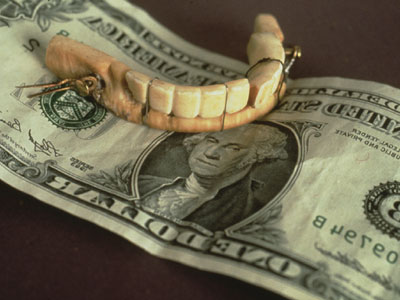
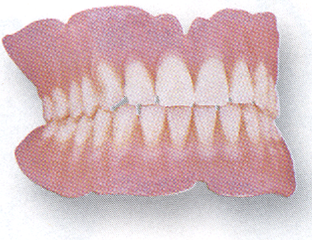
As much of the palate and soft tissues in the mouth are covered by the denture, speaking and taste are affected. “Sore spots” are a common issue with dentures as food particles become lodged under the denture or the denture rubs on the underlying gums and they become irritated. Because the denture is supported entirely by the gums and underlying bone, the forces of chewing usually result in gradual shrinking of the gum and bone tissues. This can result in loose, ill-fitting dentures, particularly on the lower arch, which in turn affects chewing and speaking. Appearance can also be affected, as the loss of jawbone contributes to wrinkles and a shrunken appearance around the mouth and lips.
Patients often state: “Just pull my teeth and make me a denture,” believing that their dental worries will be over. Nothing could be further from the truth! Dentures require maintenance, relining as bone and tissues shrink, and can significantly affect your ability to speak as well as taste and chew quality, nutritious foods. Dentures must be removed at night to allow the gums to breathe and rest.
DENTAL IMPLANTS:
Dental implants are the latest, state of the art option for replacement of missing teeth. Implants have many benefits. An implant looks and feels much like a natural tooth. Because the implant mimics the root of a natural tooth, the jawbone is stimulated with chewing. This helps keep the jawbone strong and healthy, and this keeps the implant secure within the jawbone. An implant can be used to replace a single missing tooth or many teeth. Implants are often used to support full dentures or fixed bridges, preserving precious jawbone and keeping these types of tooth replacement comfortable, secure and stable. Patients continue to report to us that dental implant placement is a simple, comfortable surgical procedure.
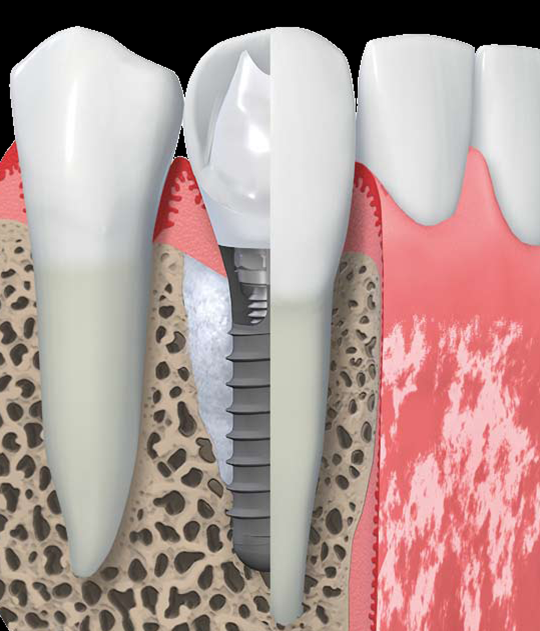
Types of Implants in Use Today
Endosteal (in the bone): This is the most commonly used type of implant. The various types include screws, cylinders or blades surgically placed into the jawbone. Each implant holds one or more prosthetic teeth. This type of implant is generally used as an alternative for patients with bridges or removable dentures.
Subperiosteal (on the bone): These are placed on top of the jaw with the metal framework’s posts protruding through the gum to hold the prosthesis. These types of implants are used for patients who are unable to wear conventional dentures and who have minimal bone height.
Immediate loading: in certain situations, an implant can be placed immediately upon removal of the natural tooth, and a crown is immediately placed on the implant. This reduces the need for multiple surgeries and multiple appointments.
Mini Implants: mini implants are smaller implants that can be used in situations where there is not enough room or bone width for a standard implant, or are sometimes used in adolescents when replacing missing teeth on a semi-permanent basis.
If you have the following conditions, implants SHOULD NOT be considered:
Uncontrolled diabetes
A history of jaw radiation, usually from cancer treatment
Immunosuppresion
Substance abuse
The following conditions limit the prognosis (success) of dental implants:
Heavy smoking or drinking
Certain auto-immune diseases
Certain mental disorders
Severe bruxism (clenching and grinding of the teeth)
Children or adolescents who are not finished growing
Patients with controlled diabetes, controlled cardiovascular disease including high blood pressure are usually excellent candidates for dental implants. Advanced age is NOT a factor when considering dental implant placement if the patient is enjoying good health. Certain medications, such as blood thinners like aspirin or coumadin will need to be stopped a few days before the implant surgery. We will communicate with you and your primary care physician if there is ANY concern about your ability to undergo dental implant surgery.
The surgery is generally relatively short (60-90 minutes from start to finish) and well tolerated. Any mild pain can usually be managed by over-the-counter products such as Aleve, Motrin or Tylenol.
ADVANTAGES OF DENTAL IMPLANTS
Dental implants provide, without question, a better solution to replacement of missing teeth.
Appearance: nothing comes closer than dental implants to looking and feeling like your own teeth. Because they fuse with your own bone, they prevent gum recession and bone loss. Only you and your dentist will know that the implant is not a natural tooth.
Preservation: with dental implant placement, no other teeth are adversely affected. Neighboring teeth do not need to be ground down or altered in any way in order to support the implant. Protection of your own teeth adds to the overall quality of your dental health.
Function: The ability to speak and eat with comfort and confidence is another added benefit of dental implants. There is no clicking, wobbling or slipping of dentures to be concerned about. There is also no adjustment to speaking or avoidance of certain foods. No worries about removing dentures or use of messy glues or pastes. Patients report again and again that dental implants look, feel and function as well as or better than their natural tooth!
Success: Today’s modern dental implants enjoy success rates of higher than 95%. Tooth replacement has never been easier or more reliable.
WHAT IF ENOUGH BONE IS NOT PRESENT TO PLACE IMPLANTS?
Surgical procedures are available to help your body to regrow the bone that has been lost. These procedures are safe and effective, and do not require bone grafting from another part of your body. Gore-tex (which is a safe Teflon membrane), creates a space into which your body’s bone cells grow unimpeded. The result is new bone, which has been shown to be more than capable of supporting implants in function over time. This procedure has been shown to be highly predictable in both animal and human studies. Dr. Tohme has performed this surgical technique thousands of times with excellent success.
This bone regeneration technique is used to improve esthetics, to rebuild bone in trauma cases, and to help stabilize dentures for patients who do not wish to have implants placed.
WHAT IF ENOUGH BONE IS NOT PRESENT TO PLACE IMPLANTS?IMPLANTS AND DENTURES OR FIXED BRIDGES:
Titanium implants may be utilized in a variety of manners to stabilize an existing denture, to support a new denture, or to replace a denture all together.
In the lower arch, two to four implants are placed which utilize newer types of attachments to stabilize a denture you already have, or to support a new denture. The result is a significant increase in comfort and function due to vastly improved denture stability.
A denture may also be eliminated completely and replaced with a fixed bridge which does not need to be removed from your mouth. Such an approach requires placement of four to six implants.
In the upper arch, two to four implants are utilized to stabilize an existing denture or to support a new denture. If four to six implants are placed, the new appliance which is fabricated has no material covering the roof of your mouth, and is as stable as natural teeth under function. This not only increases your ability to chew nutritious foods, but increases your ability to enjoy tasting delicious foods because the palate is not covered.
An added advantage to implant placement in either the upper or lower jaw is that the presence of implants helps to preserve the bone around them, thus halting the continuing bone loss which is encountered beneath full dentures.
The procedures for implant placement have been greatly simplified as the field has developed. In many instances, implants may be placed without the need for stitches. When stitches are required, simple dissolving stitches are often utilized.
Finally, even in situations where dentures have been worn for quite a long time, and significant bone loss has occurred beneath the dentures, simple procedures can be utilized to regrow your lost bone without having to take bone from another part of your body. These procedures are performed with only “Novocaine”, and once again require only a few stitches.
IMMEDIATE
Please contact our office if you wish to discuss the advantages of implant therapy and how they pertain directly to you. There is no doubt that these treatments will help to halt continuing bone loss and restore oral health, as well as maximize comfort, function and esthetics in both the short and long terms. We look forward to working with you.
